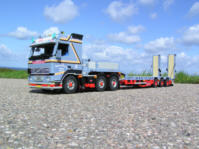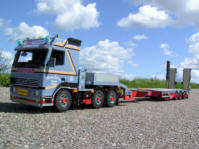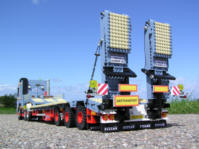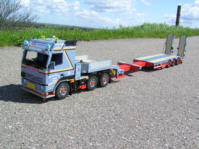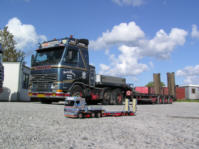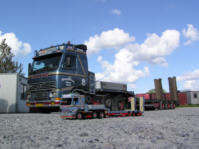Volvo FH16 6x2/4 520 with 3 axle Goldhofer step frame trailer, Scale 1:13
Motivation
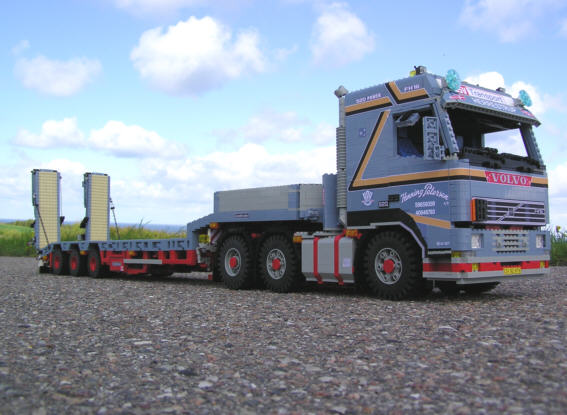 This is my third truck in scale 1:13, and the idea to create the truck came up rather early, when I started to create large scale
trucks. I have been riding a lot with this truck, and it was clear that this truck should be in my collection. If I have had time for a trip, I have
often called the driver of the truck, and asked if he would like a little company, which he ofcourse always wanted, so through the time it has
resulted in a lot of great trips. To ride along, watching lowloaders and heavy machinery is very nice I think.
This is my third truck in scale 1:13, and the idea to create the truck came up rather early, when I started to create large scale
trucks. I have been riding a lot with this truck, and it was clear that this truck should be in my collection. If I have had time for a trip, I have
often called the driver of the truck, and asked if he would like a little company, which he ofcourse always wanted, so through the time it has
resulted in a lot of great trips. To ride along, watching lowloaders and heavy machinery is very nice I think.
And now it is here, a Volvo FH16, with Goldhofer step frame trailer, from the company Henning Petersen A/S in Herrestrup, Denmark.
Below you will find a description of the truck, the features and everything else that could be interesting in this connexion.
Like my second truck in this scale 1:13, Henrik Guldager's, Sweet Candy this truck
is also built in one of the untraditional colors of LEGO, called 'Sand Blue'. Again it has been a challenge to create a truck with this color,
since it is hard to find the right bricks, and sometime you have to think different to put the bricks together, since a lot of bricks are
missing in this color.
I hope you will enjoy my description of the project, as much as I have enjoyed to create the model, have a good time!
The Original truck
The truck is owned by the hauler, Henning Petersen A/S in Herrestrup, Denmark.
The Tractor
Mainly it is a 6x2/4 configuration, specially equipped for hauling heavy machinery, road machinery, and alike.
The truck is equipped with a D16A 520 engine, 16.1 liters, row 6, with turbo and intercooler. Effect, 520 HP at 1800 rpm.
and torque of 2400 Nm at 1000-1300 rpm.
The gearbox is manual, 12 gears, + 2 slow, range/split
The Trailer
The trailer is a 3 axle extendible Goldhofer step frame trailer. The name step frame is a kind of lowloader, but it is only allowed
to carry a total of 48 tons, but it is capable of driving with a normal speed on the roads, compared to 'real' lowloaders, which can carry
more than 48 tons, but are only allowed to drive with a limited speed.
The trailer is made with a 12.80 meters floor, which can be extended 5.3 meters to a total of 18.1 meters. The rear axle is steered,
and the front axle is liftable. At the rear end, are two hydraulic ramps, and the floor can be broaden for transport
of wide machinery.
At the goose neck there is a hydraulic winch, which can be usefull for pulling up, damaged machinery and waggons.
Below you can see some pictures of the original truck, with different loads.
Data
Some of the data I have collected of the real truck is written here.
 |

| Length |
18 m |

| Load |
25 tons |

| Total weight |
48 tons |

| Engine |
Volvo D16A, row 6 , 520 HP |

| Gearbox |
12 gears, range/split |
|
|
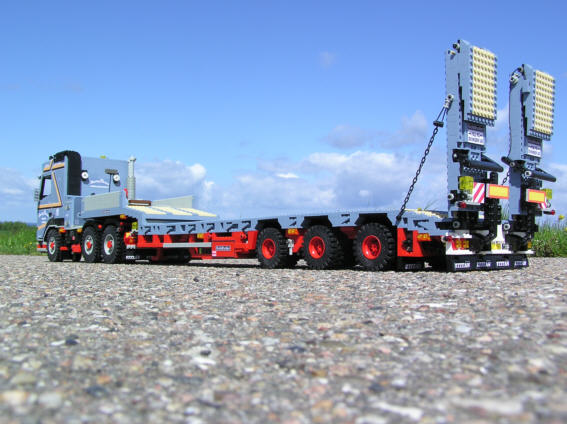
LEGO model
The tractor for this third model in scale 1:13 was a lot easier to built than the two other models. Most parts of the tractor is very
similar to my second model of Henrik Guldager's, Sweet Candy, that is also
a Volvo, just the new version, and only a FH12, but it is primarily the front part of the drivers cabin, which has been changed a bit
, so a lot of the design could be used again. Most af the chassis is the same.
On this model, I have but more work in making the chassis, compared to the Sweet Candy model, everything on this model is hidden behind
plates and chrominium. On this model everything is more visible and therefore more detailed built.
Inside the model is a little less advanced, since this truck is more conventionally equipped inside. There are no motifs on the cabin,
only lines and letters.
The color of the truck is close to the original, a little too bright, but with more or less the same nuance, the choise were between the
normal blue, and the new Sand Blue, and I think the sand blue color gives the best result, the normal blue is kind of too simple for the
truck. Again the choise of color has given a few problems, since the color is not fully updated, that means, sometime bricks of
a certain shape are missing, and you have to be a little creative to find a solution with the other shapes.
The step frame trailer has been the largest challange, it is my first step frame trailer in this scale, and the many features I wanted
to built in to the model has given a lot of problems through the building process. But now to the more detailed and technical description.
The Tractor
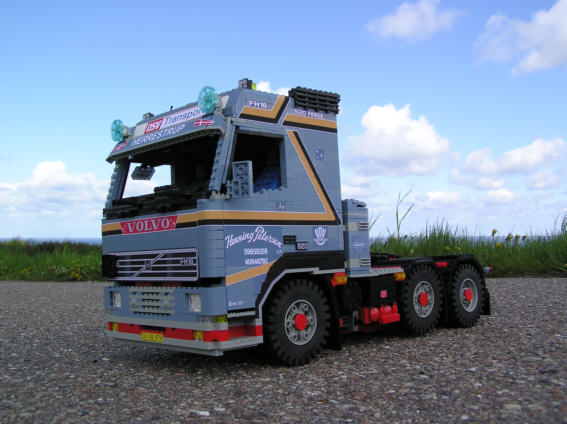
The truck is built on a 6x2/4 chassis, the socalled pusher- or twinsteer-chassis, where the rear axle is driven, and the
two front axles are steered. The cabin is a L2H2 cabin, also known as Globetrotter, the second largest cabin in the Volvo FH, range.
Chassis
The chassis is built of to longtitudinal frame sections, with supports in between.
The frontaxle is made as the original with 2 longtitudinal leaf springs and shock absorbers, the front wheels can turn and they are equipped with
an Ackermann connection to turn the innermost wheel more than the outer to give the right direction when turning.
The middle axle is also equipped with airsuspension and a pneumatic cylinder to be able to lift it from the ground.
On this model I have placed an aircompressor in the fueltank on the right side of the truck, the compressor is equipped with two pistons, since
it will later also supply the trailer with compressed air.
On the left side of the truck you will find the original batteribox and airtanks. Below the airfilter I have placed a pneumatic valve
for controlling the liftable middle axle.
The rearaxle is equipped with airsuspension, working differentiol, and a propellor shaft to the gearbox.
Around the fifth wheel which are equipped with toothbars, to look like the original movable fifth wheel, the frame is covered by
aluminium plates, they protect the chassis, and makes it easyer to walk around.
The rear bumper is special made on this truck, in a little more sturdy version compared to the standard Volvo bumper.
In both sides above the light, there are two warning signs, and near the frame two extra lights are mount to give the necessary working
light, when you reverse into a dark working area or so. In the bottom you will find all-width mudflaps with the text
'Volvo - TITAN'.
Engine
The engine is made of 3 parts, the block with gearbox, inlet- and outletsystem.
The engine is a straight 6 with working crankshaft and pistons. On the rear is the gearbox, where the rotation from the
propeller shaft is directed to the crankshaft. The engineblock is equipped with cooler, intercooler, manifold (inlet and outlet)
and a turbo system.
The inlet system, begins from above the drivers cabin, through a long channel behind the cabin, to the airfilter behind
the left front wheel, and from the airfilter to the inlet-side of the turbo.
The exhaustsystem consists of pipes from the outlet-side of the turbo, to the vertical silencers behind the right side of the
drivers cabin.
Drivers cabin - outside
In the front of the frame the bumper is mounted, on the front side in the buttom, there is a small spoiler below the normal bumper.
In the lower part of the bumper two fog-lights are mount, and to steps that can be opened to maintain the front window. In the middle the licence
plate is mount. Above this, there are to turning ligths, to small headlights and above the real frontlights. In between those, there is a grill, with
mountingframe for the 'Særtransport' (Oversize load) plates, which has to be used for oversize loads.
In both sides three steps leads to the drivers cabin. And mudguards around the frontwheels.
The cabin is mount on a junction in the front, and supported by airsuspension in the front- and rear end.
In the front there is a large leaf, to enter the engine from the front, to refill water, oil. etc. This leaf has to be
opened if the cabin is tilted for engine-service. In each side the doors can be opened. They are equipped with mirrors, one
in the left side, and two in the right side + the near-sight mirror.
In each side of the cabin behind the doors is also a small locker for tools and other equipment.
Over the front windshield the sun visor with the text 'HERRESTRUP' and two danish flags and 2 spotlights are mount.
On the roof of the cabin there are 2 top marking lights, warnings lights and two small antennas.
In between the warning light and the roofspoiler there is a small sunroof.
On the rear of the cabin, you will find working lights and the inlet for the engine.
The cabin is equipped with a lot of logoes and stripes to match the original truck.
In the front grill a sign with two orange plates are placed, that is used for dangerous goods, like diesel tanks for heavy macinery.
Drivers cabin - inside
Inside the cabin, I have also tried to create as many details as possible. The seats are blue, with black bottoms.
The dashboard is also black, with a brown line of tree built in.
In the rear the lower bed is placed, with a controlpanel for light, heat, etc. The upper bed is raised up to the roof, but can also be lowered.
Above the frontwindow there are to sunvisors that can be lowered, small rooms for stuf are also to be found.
In the roof you will find normal light, and two red night-lights.
Special equipment: fax, small box for the coffee pot, to the right of the gearlever. The instuments on the dashboard is a copy of the
original instruments.
Special equipment
This tractor is equipped wit a little extra things, specially made for heavy hauling.
Aircompressor
The tractor is equipped with an aircompressor for supplying the built in functions in the trailer. But also for the
liftable axle on the tracotr.
I have chosen to make the compressor with two pistons, since I know there has to be used a lot of air for the functions
on the trailers, and there by it will work a bit faster. The compressor with motor and 2 small pumps are built into the
fueltank on the right side of the truck.
To prevent the compressor from running all the time, when there is no need for air, I have made a preassure-regulated switch
which turns off the compressor when there is a sufficient amount of air in the system. When the air is used, the compressor will
start automaticly again, just as the original truck.
The preassure-switch is made by letting an aircylinder and a spring work against eachother, around an electric switch.
When there is not sufficient pressure in the system, the spring can push the aircylinder back, and turn on the compressor.
And when there is sufficient pressure in the system, the aircylinder can push the spring back, and turn off the compressor.
The system is placed between the two frame parts of the chassis, between the front and rear-axle.
Normally the compressor only delivers air for the middle axle to be raised/lowered. But through a hose, placed below the fifth
wheel, the airsystem on the trailer can be supplied. On the real truck the hoses for the hydraulic for the ramps on the trailer
is placed here below the fifth wheel.
I have placed a pneumatic valve in the locker behind the drivers cabin, thereby the air for the trailer can be coupled/decoupled.
The electric supply for the compressor, and later for the trailer is from a batterybox with 6 pcs. of AA batteries, hided below the
bottom bed in the drivers cabin, it can be found in the little locker in the left side of the drivers cabin.
Lockers behind the drivers cabin
Since the tractor is equipped with 3 axles, there is not much room for tools and stup in the normal lockers between front- and
rear axle. Thats why the tractor is equipped with a large locker behind the drivers cabin, to store different stuff. In the right side
of the truck the vertical silencer is placed 'inside' this locker. In the middle there is an electric supply coupling for the trailer and a
valve for controlling the airsupply for the trailer. In the top there is a small room for tools and equipment. On the left side there is
a large room for different equipment, like warning lights, straps, tools. etc. The locker is made in a shape to use the space between
the tractor and trailer in the best way.
Data
This is the final data for the tractor.
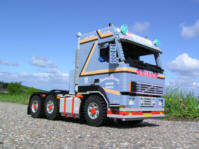 |

| Lenght |
50.2 cm |

| Widht |
19.2 cm |

| Height |
30.2 cm |

| Wheelbase |
21.1 + 10.7 cm |

| Construction time |
Around 70 hours |
|
|
Here are some extra pictures from different angles.
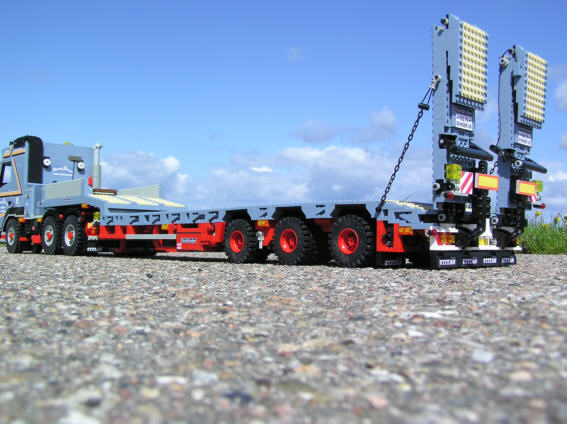
The Trailer
The trailer is a 3 axle Goldhofer step frame trailer, that means allowed to drive with normal speed. If you use different
plates for the trailer socalled 'lowloader-plates' you can use it as a lowloader too, and take a load of 41.5 tons, buth with reduced speed.
The trailer is made with on steered axle, airsuspension, extendible, winch, and working ramps,
It has been a little challenge to me to create the trailer, since it is my first in this scale, and I wanted to built in
as many working functions as possible, so it has been quite a puzzle to get everything to fit in, but all in all, I am quite
satisfied with the result.
The Chassis
The trailer is built on a heavy frame, it is actually double to be able to be exended, more about that later. The frame
consist of a rectangular tube, 8 knots wide, where the floor is placed above in its whole length.
At the rear the 3 axles are mount, the most rear axle is steered, not forced steered but, it turns when the trailer turns,
that is to decrease the turning radius, and the wear of the tires. Normally the steering is locked at a surtain speed, that
is not made on the model.
When machinery is loaded and unloaded it is important to keep the height of the floor on the trailer as low as possible.
That is quite easy to incoorporate on the real trailer, since it is airsuspensioned, and the air can just be let, and the trailer
will be lowered.
I wanted to have this lowering/raising function in the model, so I found out the best way to make this, was to make the trailer
airsuspensioned. The airsuspension contains of 6 normal pneumatic cylinders, mount longtitudinal on the trailer, with a right angle
system to direct the forces up/down instead, and they work as suspension. Thereby it is actually wuite easy to raise/lower the trailer,
since you can just lower the airsuspension, it is controlled with a small handle between the 1st and 2nd axle on the trailer, like on the original
trailer.
The front axle is also normally liftable when there is no load on the trailer, that is also possible with the airsuspension, then the front
axle is just raised/lowered seperately, that is controlled with a small handle in front of the front axle, like on the original.
It was a little hard to make the airsuspension fit in, but by packing everything quite close together, and placing the cylinders horizontal, then
it was actually possible. I have made a small video, where the trailer is lowered and raised in the airsuspension.
The videos can be viewed with Quicktime, get it here.
In the front the trailer is placed on the fifth wheel of the tractor. This part of the trailer is often called the 'Goose neck', that part
was quite tricky to built too I think. It has to bee very sturdy to carry the weight of the trailer and an eventually later load of some kind.
From the floor the frame is vertical a bit, then almost horizontal (around 80 degrees) and the horizontal over the tractor.
I have made a lot of reeinforcements in this part to make it sturdy enough.
On top of the goose neck there is a winch, and to small lockers for equipment and tools.
The winch is driven by a geared 9V motor, supplied by a wire from the battery on the tractor.
The winch is equipped with a free gear, to make it possible to pull out the wire, and not have to wait for the motor to
roll it out. In one of the lockers there chains and a large hook including a block, to make the winch capable of pulling double.
I have made a small video, showing the winch pulling the wire.
The videos can be viewed with Quicktime, get it here.
On the goose neck are also placed to small ramps, that can be placed between the floor and the goose neck, so machinery
can be driven from the floor to the goose neck. In the very front of the trailer a broom is placed, it is used for cleaning
the floor after dirty machinery has been on the floor.
Right behind the tractor, on the front part of the main frame of the trailer, to support legs are mount. They can be raised and
lowered by a small handle on the right side of the trailer.
Below the floor of the trailer you will find spare wheels, and wheel blocks in both sides.
Ramps
When machinery are loaded and undloaded from the trailer, the two ramps that are mount in the very rear of the trailer are used.
In normally driving, the ramps are placed vertical, secured with to chains with a strap and buckle in the top end.
Those ramps are a big part of the trailer, and ofcourse I wanted them to be functionally. First of all, the two ramps
are mount on to huge junctions, made so it is possible to move the ramps sideways, for loading narrow and wide machinery.
If you want to load a wide machinery, that can be moved out to be a little wider that the trailer itself. The function can be
seen on the pictures below.
Since the ramps are made like that, i.e. adjustable in the widht, the system for lowering/raisen them, are a little special too.
It is not possible to make a direct link between the ramps and trailer, instead there is made an liftarm, placed in a junction
below the floor, handlet by large cylindres, this liftarm is capable of pushing the ramp up and down, and still be able to
move the ramp sideways. On the pictures below this liftarm can be seen in the up and down position.
The ramps, are socalled 'double folders', to be long enough to give small loading angle as possible, but still not to tall in the vertical
position.
The system is working by a small wire. On the main ramp a lever is placed, it is activated by the liftarm for the ramps. When the
ramps are lowered it pushes the lever, and in the opposite end the wire is placed, the wire goes around the junction for the outer part
of the ramps, and thereby the outer part is foulded out when the ramps are lowered. On the pictures and videos below, you can see
the result.
Here are two videos showing the ramps beeing raised and lowered.
The videos can be viewed with Quicktime, get it here.
On the rear of the trailer, just below the two ramps, there are two support legs, which are also used when loading or unloading
the trailer. They are mounted right in front of the bumper, on my model I found space for placing two small pneumatic cylinders
for this function to be working.
Right behind the support legs the bumper is mount, and below that the mudflaps in the full width of the trailer. When the trailer
is lowered in the airsuspension there is no room for the mudflaps, so they are made with a junction to be folded up to the bumper,
otherwise the trailer will rest on them, instead of beeing lowered to the ground.
Here I have made two videos showing the support legs beeing raised and lowered.
The videos can be viewed with Quicktime, get it here.
Widen the trailer
Often you haul machinere, buildings, etc. which are wider than the 2.5 meters of the trailer. Then there are some
lawfully demands and some practical issues to follow.
First of all, the lawfully demands, if the vehicle with its load exceeds 2.5 meters, it has to be marked, in this case
by warningligths and plates with red/white stripes. Those plates and lights are placed under the goose neck and on the rear of
the ramps. Normally they are pushed in to the normal width of the trailer, but if the truck carries an oversize load, they can be
pulled out to warn other road users.
There should also be put a sign in the front and on the rear with the text 'SÆRTRANSPORT' which means 'special transport' in danish, also
to warn other road users about the large vehicle. The signs can be seen on the pictures below.
To improve the stability of wide machinery loaded on the trailer, the floor can be made a little wider than normal.
That is doned by turning out small frames placed along the whole lenght of the floor, when those are in a perpendicular to
the floor, heavy peaces of wood are placed on them. Thereby the floor is widened and the stability improved.
The boards are placed in a locker which goes from one side of the trailer to the other, placed in front of the 1. axle of the trailer.
Extension
Like it is possible to haul goods, wider than the the floor of the trailer, the trailer is also equipped with a system for extending
the trailer, that means it can be made longer, in this case, the real trailer can be extended 5.3 meters, resulting in a fully floor
length for 18.3 meters!
This function is also incoorporated in my LEGO model, the whole frame of the trailer is double, to rectangular tupes which can be placed
inside eachother. It was a little harder to get this work than I thought, but after some trials I succeded.
First of all the double frame, demands a lot of space, and it was not easy to find room for wheels, lockers, sparewheels, etc.
But also the strength of the trailer was hard to get sufficient enough to carry the weight of the trailer, when it has to be
extended 41 cm.
The inside frame goes all the way to the rear end of the trailer, that makes the trailer quite strong when it is not extended, since
it works as to frames. And extended it has also proven to have the necessary strength. As it can be seen on the pictures the trailer do
not need any support underneath to carry itself, which is normally often a problem with LEGO models. How much the trailer can carry when
it is extended I have not tested, but that also depends on how the loads is placed on the trailer.
On the extendible part of the trailer there is also a movable crossframe, which can be moved manually, it is used for supporting the load.
The extension is normally to be locked for every 0.5 meters, I have made the same system here, with an axle, which is placed in a hole, to lock the
extension. The handle for this axle is placed in front of the locker for the widening broads, like on the original.
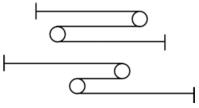 One of the tricky parts in the extendible parts, is that the compressed air has to be used for wheels, ramps and supportlegs in the rear end of the trailer,
but the air is supplied from the tractor in the front of the trailer. It is not possible to pull an airhose one halft meter, and nether to push it together in the frame,
without making knots and getting trapped, so I had to come up with another solution. So I tried to find out how it is working on the real trailer, and
that came out to be the best solution. The hoses are placed in a large 'S' shape, which are held straight all the time, but also
capable of adjust to the different lengt. The two pulleys are held by to long springs, and thereby the hose is held outstretched.
I have tried to make an illustration of the system to the right.
One of the tricky parts in the extendible parts, is that the compressed air has to be used for wheels, ramps and supportlegs in the rear end of the trailer,
but the air is supplied from the tractor in the front of the trailer. It is not possible to pull an airhose one halft meter, and nether to push it together in the frame,
without making knots and getting trapped, so I had to come up with another solution. So I tried to find out how it is working on the real trailer, and
that came out to be the best solution. The hoses are placed in a large 'S' shape, which are held straight all the time, but also
capable of adjust to the different lengt. The two pulleys are held by to long springs, and thereby the hose is held outstretched.
I have tried to make an illustration of the system to the right.
To be continued...
In the near future, I hope to present the model with some kind of load, so please pay attention to my 'Projects' page.
Data
The final data of the LEGO model.
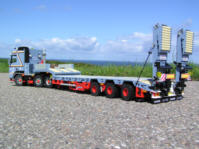 |

| Length |
131.2 - 172.2 cm |

| Width |
19.2 cm - 22.4 cm |

| Height |
30.2 cm |

| Construction time/b> |
Around 150 hours |

| Date |
February 2005 - May 2005 |
|
|
Conclusion
A small conclusion to this project. This is now my third model in the 1:13 scale, and absolutely not the last one, I
think it gets more and more fun to create the trucks, and the experience from the other trucks, makes some parts easier
so it is possible to work on new functions and details.
Again, I have had some problems with the color, but I think the result is worth the work it has been to find the right
pieces and combine the brinks in Sand Blue. Since this is my second Volvo I have created, some parts has been a lot easier
but I still find the Volvo hard to reproduce in the exact shape.
When the model was finished I had the pleasure to show the real driver of the truck, my model, also the hauler, and some other
colleagues saw it. They were very interested and I think it was fun to show all the functions and details, etc.
I also shot a few pictures, with the model and the real truck. Unfortunately the difference in color is accentuated a bit by
the sun, since metallic color gets darker in sunlight, and LEGO gets brighter, but I hope you can se the likeness anyway.
I have a lot of pictures of the model, below I have put a few of them. If you like to see more of the model or the original
truck, dont hesitate to contact me.
 This is my third truck in scale 1:13, and the idea to create the truck came up rather early, when I started to create large scale
trucks. I have been riding a lot with this truck, and it was clear that this truck should be in my collection. If I have had time for a trip, I have
often called the driver of the truck, and asked if he would like a little company, which he ofcourse always wanted, so through the time it has
resulted in a lot of great trips. To ride along, watching lowloaders and heavy machinery is very nice I think.
This is my third truck in scale 1:13, and the idea to create the truck came up rather early, when I started to create large scale
trucks. I have been riding a lot with this truck, and it was clear that this truck should be in my collection. If I have had time for a trip, I have
often called the driver of the truck, and asked if he would like a little company, which he ofcourse always wanted, so through the time it has
resulted in a lot of great trips. To ride along, watching lowloaders and heavy machinery is very nice I think.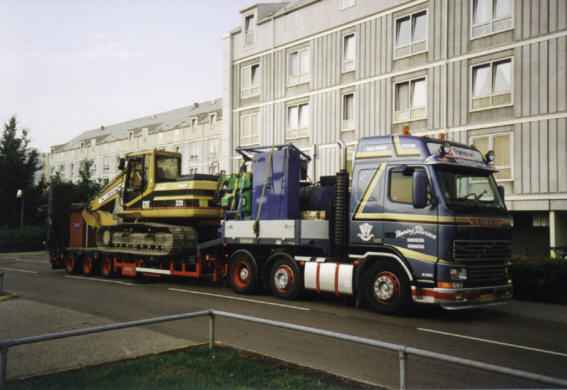
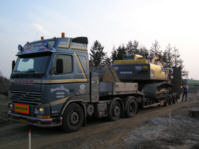

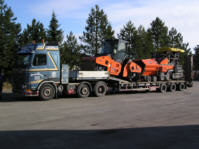
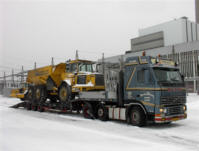







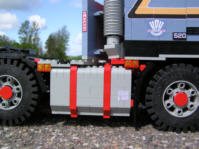

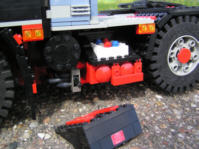
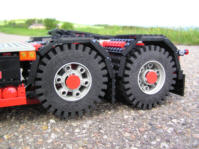
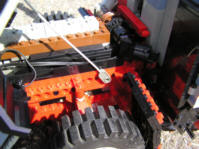
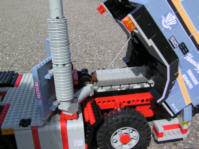
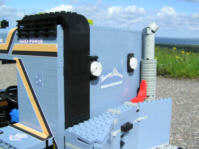
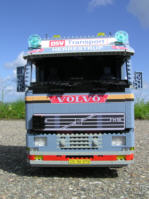
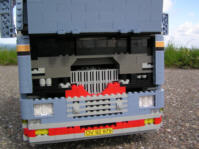
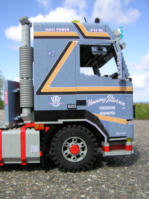
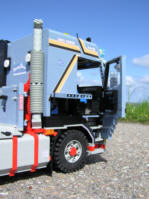
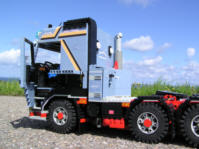
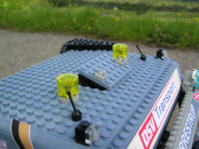
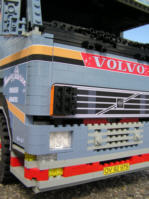
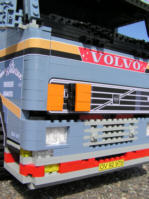
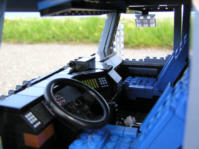
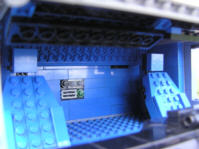
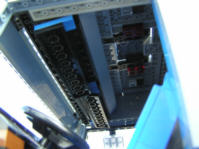
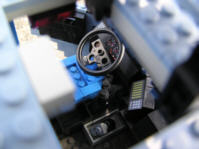
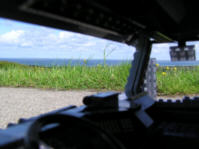
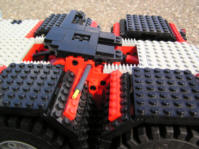
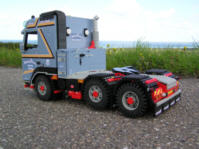
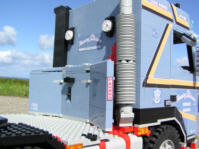
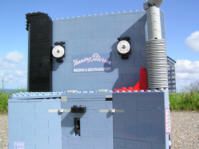
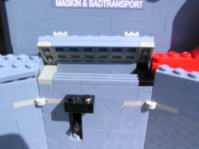
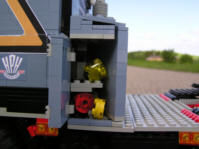

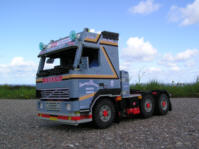
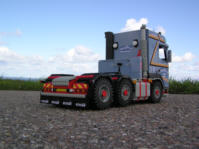
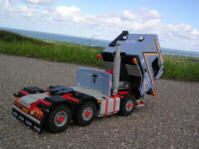
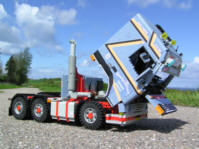

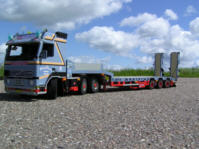
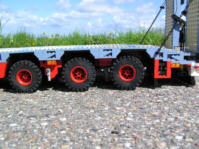
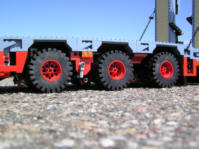
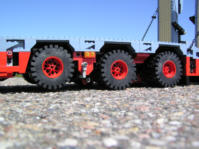
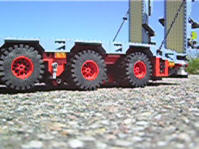

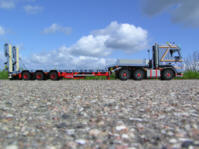

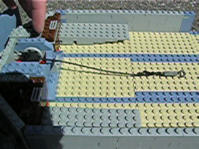
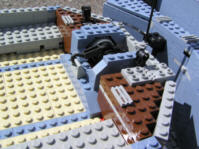
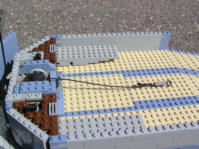
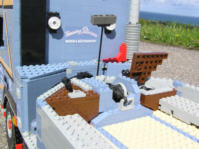
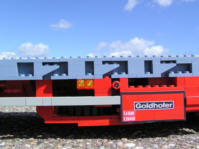
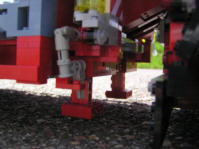
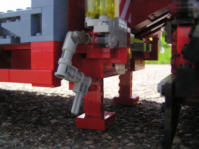

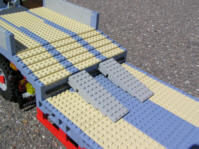
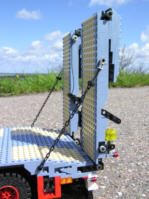
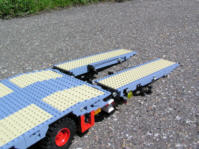

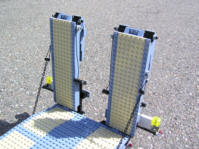

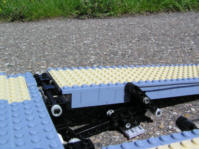
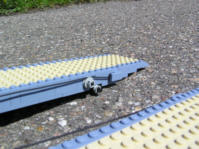
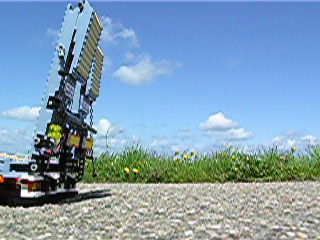


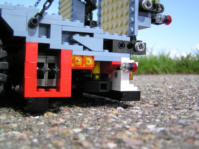
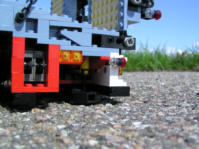
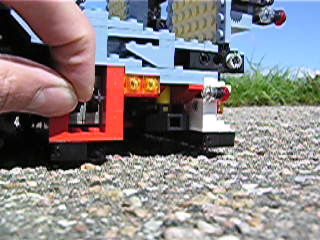
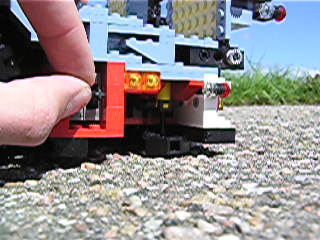
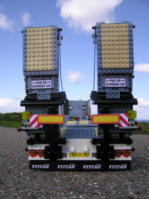
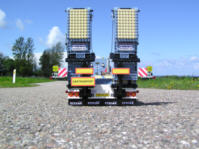

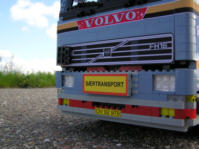
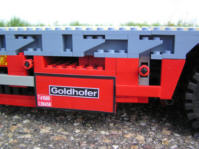
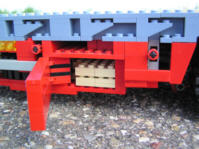
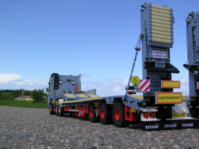
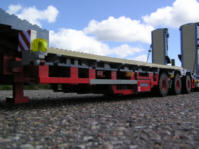
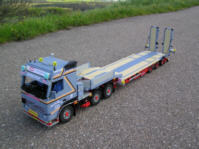
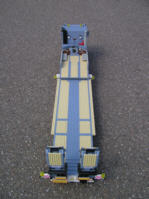
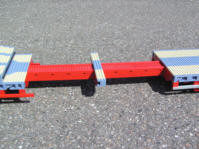
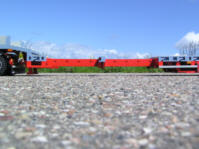

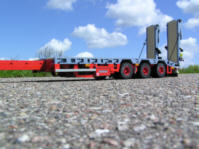
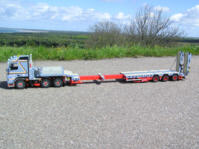
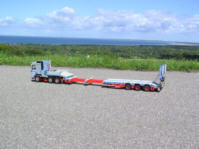
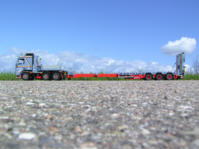


 One of the tricky parts in the extendible parts, is that the compressed air has to be used for wheels, ramps and supportlegs in the rear end of the trailer,
but the air is supplied from the tractor in the front of the trailer. It is not possible to pull an airhose one halft meter, and nether to push it together in the frame,
without making knots and getting trapped, so I had to come up with another solution. So I tried to find out how it is working on the real trailer, and
that came out to be the best solution. The hoses are placed in a large 'S' shape, which are held straight all the time, but also
capable of adjust to the different lengt. The two pulleys are held by to long springs, and thereby the hose is held outstretched.
I have tried to make an illustration of the system to the right.
One of the tricky parts in the extendible parts, is that the compressed air has to be used for wheels, ramps and supportlegs in the rear end of the trailer,
but the air is supplied from the tractor in the front of the trailer. It is not possible to pull an airhose one halft meter, and nether to push it together in the frame,
without making knots and getting trapped, so I had to come up with another solution. So I tried to find out how it is working on the real trailer, and
that came out to be the best solution. The hoses are placed in a large 'S' shape, which are held straight all the time, but also
capable of adjust to the different lengt. The two pulleys are held by to long springs, and thereby the hose is held outstretched.
I have tried to make an illustration of the system to the right.

